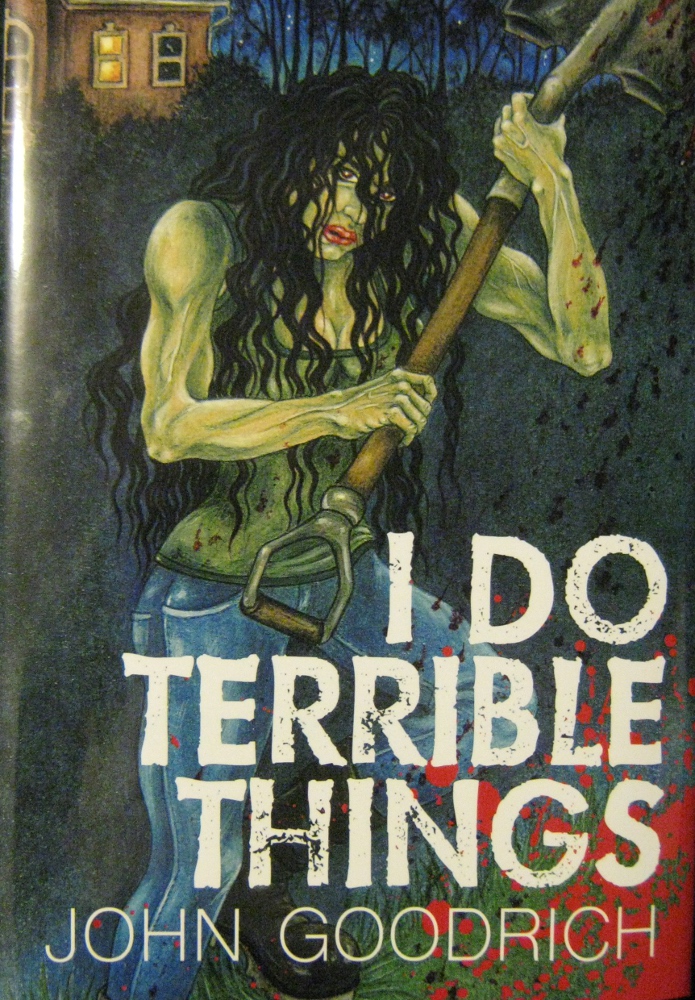This week on The Scariest Part, my guest is John Goodrich, whose latest novel is I Do Terrible Things. Here’s the publisher’s description:
Donna doesn’t know the old man with the sad face and yet there she is, beating him to death with a shovel. Is suppressed rage making her murder people in horrifying ways, or is she some sort of latent psychopath? The more people she kills, the more desperate she becomes to stop herself. Can she find the key before she commits yet another gruesome murder?
And now, let’s hear what the scariest part was for John Goodrich:
What sets you off? Really sets you off? Pushes you straight past angry into furious, even to that place when you can visualize killing someone? I bet there’s a couple of things you’re thinking about right now. We all have them. A subject, a person, something that gets under your skin and raises your blood pressure instantly. Being enraged enough to kill is a classic of the horror genre, going back to Poe’s “Cask of Amontillado” and even further. That rage can be cold and calculating, like Montresor, or it can be wild and furious, as in Poe’s lesser-known “Hop-Frog.”
Can you imagine yourself actually doing it? The rush of rage, the burning need to do something leading you to a desperate act. There’s something seductive about it, being pushed too far. It’s liberating. We spend a lot of our time ignoring the slings and arrows of injury and insult, and it builds up. So it’s not difficult to make a character taking their revenge sympathetic.
But how to make a protagonist, in I Do Terrible Things her name is Donna, sympathetic if she lacks that motivation? If the story just starts out with her beating someone with a shovel, with no clear reason? And not only does the audience not know why, she doesn’t either. It’s a great hook, but how do I make Donna someone the reader is interested in following? It’s the writer’s job to take the reader down paths they don’t expect, and I’m trusting the reader on this one. I didn’t feel the need to make Donna as instantly understandable as my protagonists have been in the past.
I also want the reader to feel the disconnect between the usual revenge tale and what Donna is doing. To make it hit home, the violence had to be realistic. Realistic violence often gets labelled as brutal, since audiences are used to network TV’s non-messy action. So the blood pumps, bones break, skin chars, and Donna has a hard time dealing with it. Because very few people can beat a man to death with a shovel and not be affected by it.
With the need for graphic violence and a lessened need to make Donna completely agreeable, I was left with the question of how far I could go with the blood. I’ve written action, but never before with the intent to make it disturbing or graphic. So I wrote what I thought was necessary, and as I did so, the violence got very dark. Not because I was escalating, but because there are so many different and horrible ways to kill people. There had been lines I told myself I would not cross, and in the course of writing, I had crossed them. As I pushed my personal comfort zone, I wondered how far I would go. Would I be writing splatter like Brian Keene? Wrath James White? Ed Lee?
It turned out that I was writing like myself. That was the scariest part. That I wrote it. Yes, I had influences, but I had intended for the book to go in that direction from the beginning. This violent book grew entirely out of me. I wrote the scene where Donna slams a guy’s face down on a hot barbecue grill. The part where she smashes a guy’s head in with a baseball bat? That was me. To see someone who wrote something disturbingly bloody and brutal, I just look in the mirror. It’s all me.
John Goodrich: Website / Facebook / Twitter
I Do Terrible Things: Thunderstorm Books
John Goodrich has written a dozen short stories in such anthologies as Cthulhu’s Dark Cults, Steampunk Cthulhu, and the Fossil Lake trilogy of anthologies. I Do Terrible Things is his second novel. He lives in Shirley Jackson’s corner of Vermont, which should be inspiration enough for anybody. His current writing technique involves smashing his head against the keyboard.



Leave a Reply